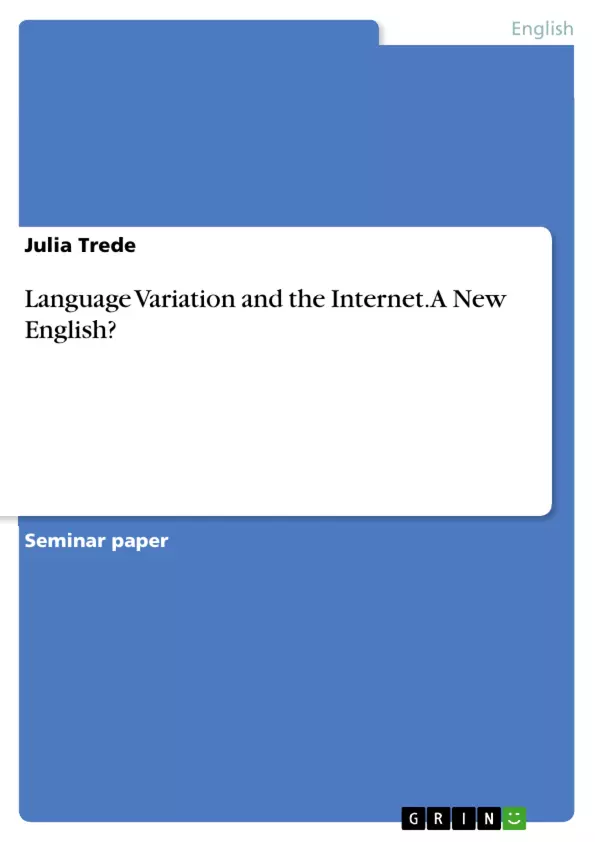Book printing, telegraph, telephone and broadcasting – all these communication technologies influenced our language and so does the Internet. This term paper examines if the invention of the Internet triggered a language revolution and if a new English has evolved.
In order to analyze the language of the Internet, it is necessary to provide a basic framework which is subject to the first chapter. Chapter one provides background information on the concept of language variation and explains important features of language variety. Dealing with language variety is crucial since the subsequent analysis aims to identify if a language variety has evolved. The second chapter deals with the definition and limitation of existing Internet situations which will be separately analyzed in chapter four. The subsequent chapter is concerned with the concept of Netspeak which was initially introduced by the linguist David Crystal. Besides the determination of Netspeak, chapter three also differentiates written and spoken language, in order to analyze whether Netspeak can be considered either spoken or written language. Furthermore, main linguistic features of Netspeak will be examined in order to compare them with each Internet situation. This procedure enables to answeri the question whether the “language of the Internet” can be considered homogenous or whether each situation applies different linguistic features. Chapter four comprises a detailed analysis of the Internet situations e-mail, chatgroups, virtual worlds and World Wide Web. In the course of this chapter, each situation will be examined according to unique linguistic features to find out if a new language variety has emerged. Additionally, special attention is given to linguistic features of Netspeak to clarify if the language of the Internet can be considered a homogenous language or a language which differs from situation to situation.
Inhaltsverzeichnis (Table of Contents)
- Introduction
- Language Variation
- Why does a language vary?
- Features of a language variety
- Defining Internet situations
- Chatgroups
- Synchronous chatgroups
- Asynchronous chatgroups
- Virtual worlds
- World Wide Web
- Netspeak
- Definition of Netspeak
- Differences between written and spoken language
- Features of Netspeak – A reflection of written or spoken language?
- Main Linguistic features of Netspeak
- Characterization of the language used in Internet situations
- Chatgroups
- Asynchronous Chatgroups
- Synchronous Chatgroups
- Virtual Worlds
- World Wide Web
- Conclusion
Zielsetzung und Themenschwerpunkte (Objectives and Key Themes)
This paper aims to analyze whether the invention of the Internet has triggered a language revolution and if a new English has emerged. To achieve this goal, the paper delves into the concept of language variation and its features, providing a framework for analyzing the language of the Internet. It then examines the different Internet situations, defining and limiting their scope before analyzing them individually. The paper also explores the concept of Netspeak, defining it and comparing its features to both spoken and written language.
- Language variation and its impact on the Internet
- The definition and characterization of different Internet situations
- The emergence and features of Netspeak as a distinct language variety
- Analysis of the language used in different Internet situations to identify potential language change
- Exploring the potential for a homogenous "language of the Internet" or variation across different situations
Zusammenfassung der Kapitel (Chapter Summaries)
- Introduction: This chapter introduces the topic of the paper, highlighting the potential impact of the Internet on language and outlining the research question: has the Internet triggered a language revolution and led to the evolution of a new English? It presents the structure of the paper and mentions the key sources for the analysis.
- Language Variation: This chapter provides a background on the concept of language variation, explaining the different types of variation and their key features. This includes regional dialects, social dialects, and register and style. The chapter aims to establish a linguistic basis for analyzing the language of the Internet.
- Defining Internet situations: This chapter focuses on defining and delimiting different Internet situations that will be analyzed in the paper. These include e-mail, chatgroups (synchronous and asynchronous), virtual worlds, and the World Wide Web.
- Netspeak: This chapter examines the concept of Netspeak, initially introduced by linguist David Crystal. It defines Netspeak and explores the differences between written and spoken language, considering whether Netspeak can be categorized as either. The chapter also investigates the main linguistic features of Netspeak, comparing them to the different Internet situations.
- Characterization of the language used in Internet situations: This chapter presents a detailed analysis of the language used in each of the defined Internet situations: e-mail, chatgroups, virtual worlds, and the World Wide Web. The chapter explores the unique linguistic features of each situation, examining how they vary and whether they contribute to the emergence of a new language variety. The chapter also considers the role of Netspeak in these situations, assessing its potential for homogenization or variation across different platforms.
Schlüsselwörter (Keywords)
The main keywords and focus topics of this paper include language variation, Internet language, Netspeak, e-mail, chatgroups, virtual worlds, World Wide Web, new English, sociolinguistics, and computational linguistics.
- Arbeit zitieren
- Julia Trede (Autor:in), 2013, Language Variation and the Internet. A New English?, München, GRIN Verlag, https://www.hausarbeiten.de/document/511360


